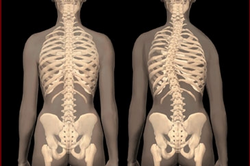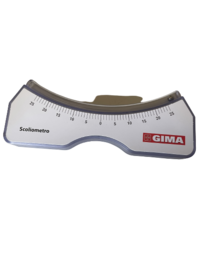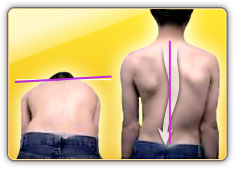Adam's forward bend test: Difference between revisions
No edit summary |
(updated youtube video and spelling correction) |
||
| (25 intermediate revisions by 12 users not shown) | |||
| Line 1: | Line 1: | ||
= | <div class="editorbox">
| ||
'''Original Editor ''' [[User:Heleen Van Cleynenbreugel|Heleen Van Cleynenbreugel]] | |||
'''Top Contributors''' - {{Special:Contributors/{{FULLPAGENAME}}}} | |||
</div> | |||
== | == Purpose == | ||
[[Image:Foto 3.png|250x250px|alt=|thumb| <small>''a)Neutral spine. b) Scoliotic spine''</small>]]The purpose of Adam’s forward bend test is to detect structural or functional [[scoliosis]]. This test is most often used during school screening for scoliosis. <ref name="[2]" /> <ref name="[3]" /> It can also be used with patients who have a family history of scoliotic posture or with patients who have detectable [[scoliosis]] of uncertain aetiology. The scoliosis is functional when the characteristics of scoliosis become more visible while the patient bends. With structural scoliosis, the scoliotic deformity will remain the same as in the standing position. <ref name="[11]">Buckup K. Clinical Tests for the Musculoskeletal System: Examinations-Signs-Phenomena. Adams Forward Bend Test.</ref>If there is an increased kyphosis when bending forward, [[Scheuermann's Kyphosis|Scheuermann’s disease]] or [[Congenital Spine Deformities|congential kyphosis]] is also possible. <ref name="[12]">Clarke A, Jones A, O'Malley M. ABC of Spinal Disorders. Examination. Oxford, 2010. P12.</ref> <ref name="[13]">Flynn JM. [https://books.google.com/books?hl=en&lr=&id=9Wm2-la1KoAC&oi=fnd&pg=PR11&dq=D.L.+Skaggs,+J.M.+Flynn.+Staying+out+of+trouble+in+pediatric+orthopaedics.+Examination+of+the+spine.+Philadelphia,+2006.+P20-21.+Level+of+evidence:+D&ots=d_mu8QW6Af&sig=6ixw9stb8lXMptyHzJ7RiuQJLos Staying out of trouble in pediatric orthopaedics]. Lippincott Williams & Wilkins; 2006.</ref> | |||
== Technique == | |||
[[File:Scoliometer.png|thumb|267x267px| <small>''Scoliometer''</small>]] | |||
Before you perform the Adam’s forward bend test, it is best to look for [[Leg Length Discrepancy|limb length discrepancy]]. The [[Lumbar Anatomy|spine]] needs to be visible. The patient bends forward at the waist until the back comes in the horizontal plane, with feet together, arms hanging and knees extended. The palms are held together. The examiner looks from behind, along the horizontal plane of the column vertebrae. The examiner looks for indicators of scoliosis, such as spinal asymmetry, unlevel shoulders, scapula asymmetry, unlevel hips, and the head that does not line up with the [[pelvis]] or a rib hump. An increased or decreased [[Posture|lordosis/kyphosis]] can also be a sign of scoliosis. <ref name="[15]">Scoliosis 3DC- Schroth Method Exercise. Is it Scoliosis? http://scoliosis3dc.com/scoliosis-information/is-it-scoliosis/ (accessed 17 November 2011)</ref>, <ref name="[16]">Scoliosis Research Society. What Are the Signs of Scoliosis? http://www.srs.org/patient_and_family/patient_handbook/what_are_the_signs_of_scoliosis.htm (accessed 17 November 2011)</ref> The rotation deformity or rib hump can be measured with a scoliometer. <ref name="[4]" /> <ref name="[12]" /> <ref name="[13]" /> <ref name="[14]">Dutton M. [https://books.google.com/books?hl=en&lr=&id=qQH7qyg37egC&oi=fnd&pg=PR1&dq=M.+Dutton.+Orthopaedics+for+the+Physical+Therapist+Assistant.+Chapter+22.+Ontario.+P616.+Level+of+evidence:+D&ots=gJgBektZOu&sig=UgFHc7_D7rdydO2AZkjYxDij6AQ Orthopaedics for the physical therapist assistant]. Jones & Bartlett Publishers; 2011 Apr 15.</ref> <ref name="[17]">J. B. Emans, D. Hedequist, R. Miller et al. Reference Manual for the Boston Scoliosis Brace. 2003. P23 http://www.srs.org/professionals/education_materials/SRS_bracing_manual/section5.pdf (accessed 19 November) </ref> | |||
[[Image:Foto 1.png|alt=|frame|<small>On the right side, the rib hump (convex side)</small>]] | |||
< | # The patient takes off his/her t-shirt so that the spine is visible. | ||
# The patient needs to bend forward, starting at the waist until the back comes in the horizontal plane, with the feet together, arms hanging and the knees in extension. The palms are held together. | |||
# The examiner stands at the back of the patient and looks along the horizontal plane of the spine, searching for abnormalities of the spinal curve, like increased or decreased lordosis/ kyphosis, and an asymmetry of the trunk.<ref name="[1]">iScoliosis. Symptoms. http://www.iscoliosis.com/symptoms.html (accessed 11 November 2011)</ref> <ref name="[2]">Scoliosis. In Depth Review of Scoliosis: Introduction, Clinical. http://www.e-radiography.net/radpath/s/scoliosis/scoliosis.htm (accessed 11 November 2011)</ref> <ref name="[3]">Scoliosis. Physical Examination. http://adam.about.net/reports/000068_5.htm (accessed 11 November 2011)</ref> <ref name="[4]">Reamy BV, Slakey JB. [https://www.aafp.org/pubs/afp/issues/2001/0701/p111.html Adolescent idiopathic scoliosis: review and current concepts]. American family physician. 2001 Jul 1;64(1):111-7.</ref> | |||
< | '''A positive test is indicated if asymmetry is observed (one side of the spine is higher than the other).''' | ||
{{#ev:youtube|7bfp0fcfH7E|300}}<ref>Scoliosis Research Society. SRS Educational Video: Scoliosis Screening Exam. Available from: https://www.youtube.com/watch?v=7bfp0fcfH7E [last accessed 26/1/2023]</ref> | |||
< | == Evidence == | ||
The Adam’s forward bend test in school screening for scoliosis is best combined with other tests for scoliosis, like the scoliometer, especially for accurate early detection. <ref name="[22]">Karachalios T, Sofianos J, Roidis N, Sapkas G, Korres D, Nikolopoulos K. [https://journals.lww.com/spinejournal/fulltext/1999/11150/ten_year_follow_up_evaluation_of_a_school.6.aspx Ten-year follow-up evaluation of a school screening program for scoliosis: Is the forward-bending test an accurate diagnostic criterion for the screening of scoliosis?]. Spine. 1999 Nov 15;24(22):2318.</ref> <ref name="[23]">A M Virginia, EJ Elliott. The hands-on guide to imaging. Evidence based pediatrics and child health. London, 2004. p175-177. </ref> <ref name="[24]">Simpson R, Gemmell H. [https://link.springer.com/article/10.1186/1746-1340-14-26 Accuracy of spinal orthopaedic tests: a systematic review]. Chiropractic & Osteopathy. 2006 Dec;14:1-0.</ref> <ref name="[25]">Fong DY, Lee CF, Cheung KM, Cheng JC, Ng BK, Lam TP, Mak KH, Yip PS, Luk KD. [https://journals.lww.com/spinejournal/Fulltext/2010/05010/A__Study_of_the_Diagnostic_Accuracy_and.00010.aspx A meta-analysis of the clinical effectiveness of school scoliosis screening. Spine]. 2010 May 1;35(10):1061-71.</ref> | |||
< | A 10-year follow-up evaluation about the effectiveness of school screening for scoliosis shows that Adam’s forward bend test has a sensitivity of 84.3%, a specificity of 93.44% for a cobb angle >10° but the authors of the study concluded that the forward bend test alone was ineffective for detecting scoliosis, owing to the high number of false-negative results.<ref name="[22]" />. A meta-analysis of the clinical effectiveness of school scoliosis screening programs suggests that programs using the forward bending test as the only screening tool had a higher referral rate and a lower precision in detecting scoliotic curves.<ref name="[25]" /> | ||
< | The Adam’s forward bend test in patients with scoliosis of 40°, has a sensitivity of 0.83 and a specificity of 0.99. When looking at the thoracic and lumbar curves, found a sensitivity of respectively 92% and 73%. The specificity is 60% and 68%. <ref name="[24]" /> <ref name="[26]">Goldberg CJ, Dowling FE, Fogarty EE, Moore DP. [https://europepmc.org/article/med/7676334 School scoliosis screening and the United States Preventive Services Task Force]. An examination of long-term results. Spine. 1995 Jun 1;20(12):1368-74.</ref> The interexaminer agreement is moderate in the thoracic spine (0.61) and poor in the lumbar spine. <ref name="[21]">Côté P, Kreitz BG, Cassidy JD, Dzus AK, Martel J. [https://journals.lww.com/spinejournal/Fulltext/1998/04010/A__Study_of_the_Diagnostic_Accuracy_and.11.aspx A study of the diagnostic accuracy and reliability of the Scoliometer and Adam's forward bend test]. Spine. 1998 Apr 1;23(7):796-802.</ref> <ref name="[23]" /> | ||
== References == | |||
<references /> | |||
== | |||
[[Category:Special_Tests]] | |||
[[Category:Rehabilitation Foundations]] | |||
[[Category:Lumbar Spine]] | |||
Latest revision as of 23:14, 26 January 2023
Original Editor Heleen Van Cleynenbreugel
Top Contributors - Heleen Van Cleynenbreugel, Lydia Xenou, Stella Constantinides, Kim Jackson, Aminat Abolade, George Prudden, 127.0.0.1, Admin, Magdalena Hytros, WikiSysop, Vidya Acharya and Claire Knott
Purpose[edit | edit source]
The purpose of Adam’s forward bend test is to detect structural or functional scoliosis. This test is most often used during school screening for scoliosis. [1] [2] It can also be used with patients who have a family history of scoliotic posture or with patients who have detectable scoliosis of uncertain aetiology. The scoliosis is functional when the characteristics of scoliosis become more visible while the patient bends. With structural scoliosis, the scoliotic deformity will remain the same as in the standing position. [3]If there is an increased kyphosis when bending forward, Scheuermann’s disease or congential kyphosis is also possible. [4] [5]
Technique[edit | edit source]
Before you perform the Adam’s forward bend test, it is best to look for limb length discrepancy. The spine needs to be visible. The patient bends forward at the waist until the back comes in the horizontal plane, with feet together, arms hanging and knees extended. The palms are held together. The examiner looks from behind, along the horizontal plane of the column vertebrae. The examiner looks for indicators of scoliosis, such as spinal asymmetry, unlevel shoulders, scapula asymmetry, unlevel hips, and the head that does not line up with the pelvis or a rib hump. An increased or decreased lordosis/kyphosis can also be a sign of scoliosis. [6], [7] The rotation deformity or rib hump can be measured with a scoliometer. [8] [4] [5] [9] [10]
- The patient takes off his/her t-shirt so that the spine is visible.
- The patient needs to bend forward, starting at the waist until the back comes in the horizontal plane, with the feet together, arms hanging and the knees in extension. The palms are held together.
- The examiner stands at the back of the patient and looks along the horizontal plane of the spine, searching for abnormalities of the spinal curve, like increased or decreased lordosis/ kyphosis, and an asymmetry of the trunk.[11] [1] [2] [8]
A positive test is indicated if asymmetry is observed (one side of the spine is higher than the other).
Evidence[edit | edit source]
The Adam’s forward bend test in school screening for scoliosis is best combined with other tests for scoliosis, like the scoliometer, especially for accurate early detection. [13] [14] [15] [16]
A 10-year follow-up evaluation about the effectiveness of school screening for scoliosis shows that Adam’s forward bend test has a sensitivity of 84.3%, a specificity of 93.44% for a cobb angle >10° but the authors of the study concluded that the forward bend test alone was ineffective for detecting scoliosis, owing to the high number of false-negative results.[13]. A meta-analysis of the clinical effectiveness of school scoliosis screening programs suggests that programs using the forward bending test as the only screening tool had a higher referral rate and a lower precision in detecting scoliotic curves.[16]
The Adam’s forward bend test in patients with scoliosis of 40°, has a sensitivity of 0.83 and a specificity of 0.99. When looking at the thoracic and lumbar curves, found a sensitivity of respectively 92% and 73%. The specificity is 60% and 68%. [15] [17] The interexaminer agreement is moderate in the thoracic spine (0.61) and poor in the lumbar spine. [18] [14]
References[edit | edit source]
- ↑ 1.0 1.1 Scoliosis. In Depth Review of Scoliosis: Introduction, Clinical. http://www.e-radiography.net/radpath/s/scoliosis/scoliosis.htm (accessed 11 November 2011)
- ↑ 2.0 2.1 Scoliosis. Physical Examination. http://adam.about.net/reports/000068_5.htm (accessed 11 November 2011)
- ↑ Buckup K. Clinical Tests for the Musculoskeletal System: Examinations-Signs-Phenomena. Adams Forward Bend Test.
- ↑ 4.0 4.1 Clarke A, Jones A, O'Malley M. ABC of Spinal Disorders. Examination. Oxford, 2010. P12.
- ↑ 5.0 5.1 Flynn JM. Staying out of trouble in pediatric orthopaedics. Lippincott Williams & Wilkins; 2006.
- ↑ Scoliosis 3DC- Schroth Method Exercise. Is it Scoliosis? http://scoliosis3dc.com/scoliosis-information/is-it-scoliosis/ (accessed 17 November 2011)
- ↑ Scoliosis Research Society. What Are the Signs of Scoliosis? http://www.srs.org/patient_and_family/patient_handbook/what_are_the_signs_of_scoliosis.htm (accessed 17 November 2011)
- ↑ 8.0 8.1 Reamy BV, Slakey JB. Adolescent idiopathic scoliosis: review and current concepts. American family physician. 2001 Jul 1;64(1):111-7.
- ↑ Dutton M. Orthopaedics for the physical therapist assistant. Jones & Bartlett Publishers; 2011 Apr 15.
- ↑ J. B. Emans, D. Hedequist, R. Miller et al. Reference Manual for the Boston Scoliosis Brace. 2003. P23 http://www.srs.org/professionals/education_materials/SRS_bracing_manual/section5.pdf (accessed 19 November)
- ↑ iScoliosis. Symptoms. http://www.iscoliosis.com/symptoms.html (accessed 11 November 2011)
- ↑ Scoliosis Research Society. SRS Educational Video: Scoliosis Screening Exam. Available from: https://www.youtube.com/watch?v=7bfp0fcfH7E [last accessed 26/1/2023]
- ↑ 13.0 13.1 Karachalios T, Sofianos J, Roidis N, Sapkas G, Korres D, Nikolopoulos K. Ten-year follow-up evaluation of a school screening program for scoliosis: Is the forward-bending test an accurate diagnostic criterion for the screening of scoliosis?. Spine. 1999 Nov 15;24(22):2318.
- ↑ 14.0 14.1 A M Virginia, EJ Elliott. The hands-on guide to imaging. Evidence based pediatrics and child health. London, 2004. p175-177.
- ↑ 15.0 15.1 Simpson R, Gemmell H. Accuracy of spinal orthopaedic tests: a systematic review. Chiropractic & Osteopathy. 2006 Dec;14:1-0.
- ↑ 16.0 16.1 Fong DY, Lee CF, Cheung KM, Cheng JC, Ng BK, Lam TP, Mak KH, Yip PS, Luk KD. A meta-analysis of the clinical effectiveness of school scoliosis screening. Spine. 2010 May 1;35(10):1061-71.
- ↑ Goldberg CJ, Dowling FE, Fogarty EE, Moore DP. School scoliosis screening and the United States Preventive Services Task Force. An examination of long-term results. Spine. 1995 Jun 1;20(12):1368-74.
- ↑ Côté P, Kreitz BG, Cassidy JD, Dzus AK, Martel J. A study of the diagnostic accuracy and reliability of the Scoliometer and Adam's forward bend test. Spine. 1998 Apr 1;23(7):796-802.









